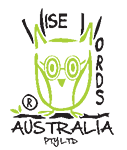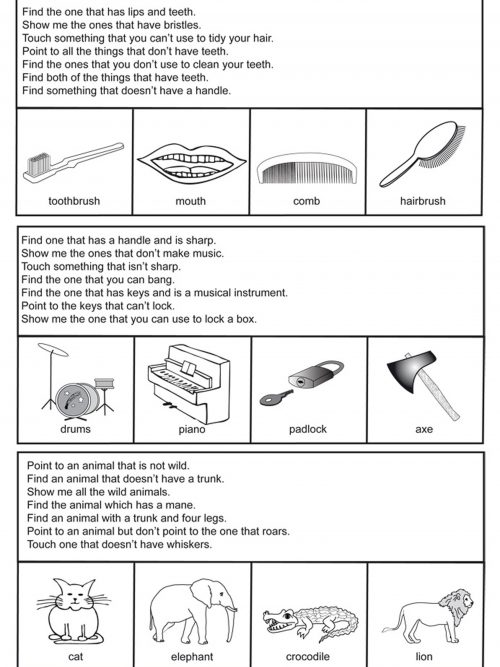-
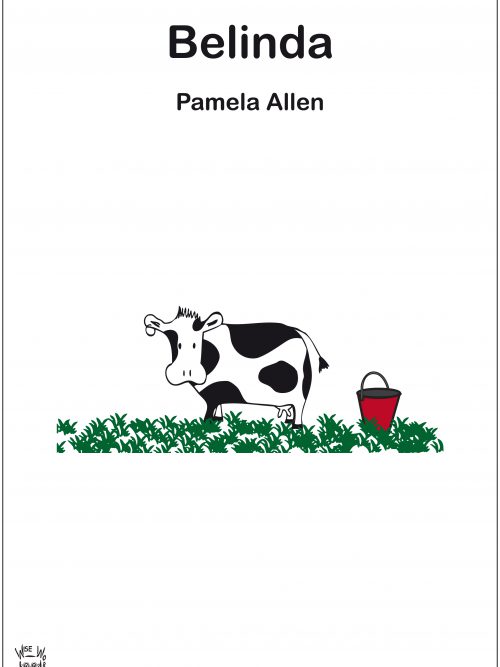 USING BOOKS TO ENHANCE A CHILD'S UNDERSTANDING AND INCREASE HIS/HER EXPRESSIVE LANGUAGE You can use a book to expand a child's • vocabulary (beetroot, paddock, trotting, rope, apron, disguise) • understanding of concepts (e.g. carefully, fattest, pretty, firmly) • ability to understand questions Wise Words Scripts - offer clinicians, teachers and parents readily available questions designed specifically for each book. A script provides a variety of questions at each level of understanding for each page of the book. A teacher or clinician working with a group of children can tailor questions to each child's language ability. This script and other available scripts have been based on Marion Blank's Model of Classroom Language. Marion Blank recognised the importance of keeping questions and statements within a child’s level of understanding. The more concrete the statement or question, the easier it will be for the child to understand. As questions become more abstract, they become harder for children to answer. The Blank Model is divided into 4 levels of questioning, moving from the concrete (easiest) at Level 1 to the abstract (most difficult) at Level 4.
USING BOOKS TO ENHANCE A CHILD'S UNDERSTANDING AND INCREASE HIS/HER EXPRESSIVE LANGUAGE You can use a book to expand a child's • vocabulary (beetroot, paddock, trotting, rope, apron, disguise) • understanding of concepts (e.g. carefully, fattest, pretty, firmly) • ability to understand questions Wise Words Scripts - offer clinicians, teachers and parents readily available questions designed specifically for each book. A script provides a variety of questions at each level of understanding for each page of the book. A teacher or clinician working with a group of children can tailor questions to each child's language ability. This script and other available scripts have been based on Marion Blank's Model of Classroom Language. Marion Blank recognised the importance of keeping questions and statements within a child’s level of understanding. The more concrete the statement or question, the easier it will be for the child to understand. As questions become more abstract, they become harder for children to answer. The Blank Model is divided into 4 levels of questioning, moving from the concrete (easiest) at Level 1 to the abstract (most difficult) at Level 4. -
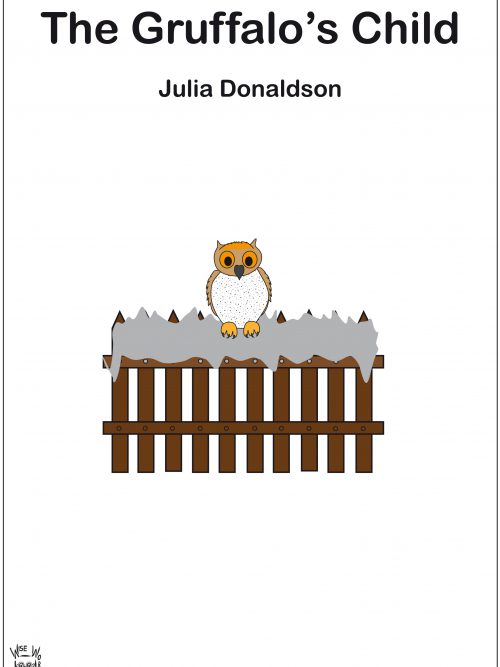 USING BOOKS TO ENHANCE A CHILD'S UNDERSTANDING AND INCREASE HIS/HER EXPRESSIVE LANGUAGE You can use a book to expand your child's • Vocabulary (boulder, trunk, basket, gleamed, log pile) • Understanding of concepts (bored, brave, wild) • Ability to understand questions Wise Words Scripts - offer clinicians, teachers and parents readily available questions designed specifically for each book. A script provides a variety of questions at each level of understanding for each page of the book. A teacher or clinician working with a group of children can tailor questions to each child's language ability. This script and other available scripts have been based on Marion Blank's Model of Classroom Language. Marion Blank recognised the importance of keeping questions and statements within a child’s level of understanding. The more concrete the statement or question, the easier it will be for the child to understand. As questions become more abstract, they become harder for children to answer. The Blank Model is divided into 4 levels of questioning, moving from the concrete (easiest) at Level 1 to the abstract (most difficult) at Level 4.
USING BOOKS TO ENHANCE A CHILD'S UNDERSTANDING AND INCREASE HIS/HER EXPRESSIVE LANGUAGE You can use a book to expand your child's • Vocabulary (boulder, trunk, basket, gleamed, log pile) • Understanding of concepts (bored, brave, wild) • Ability to understand questions Wise Words Scripts - offer clinicians, teachers and parents readily available questions designed specifically for each book. A script provides a variety of questions at each level of understanding for each page of the book. A teacher or clinician working with a group of children can tailor questions to each child's language ability. This script and other available scripts have been based on Marion Blank's Model of Classroom Language. Marion Blank recognised the importance of keeping questions and statements within a child’s level of understanding. The more concrete the statement or question, the easier it will be for the child to understand. As questions become more abstract, they become harder for children to answer. The Blank Model is divided into 4 levels of questioning, moving from the concrete (easiest) at Level 1 to the abstract (most difficult) at Level 4. -
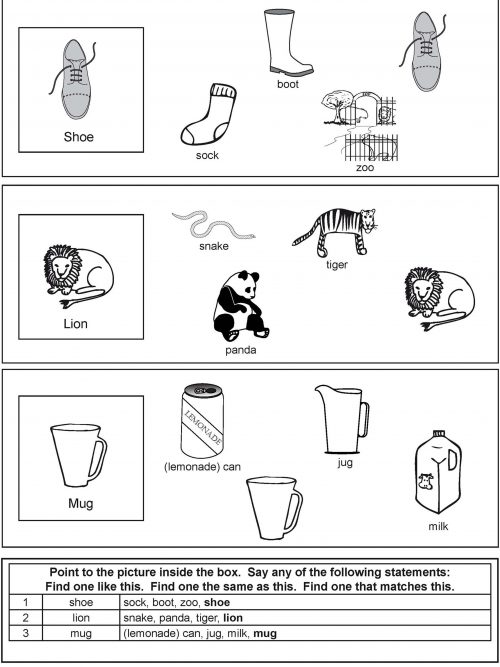
Level 1
Scanning for a Matching Object Level 1 “Find one like this.” “Find one that matches this.” “Find one the same as this.” Naming an Object Touched Level 1 “What is the name of the thing you just touched?” “What’s the thing that you just touched called?” “The thing you touched is under here. (Pointing to the same object but now covered.) What’s it called?” These worksheets are targeted at Level 1 - The questions and statements at this level require a child to understand or respond to information which is “here and now” and always in front of the child. Some early responses may consist of non-verbal gestures (pointing) or single words. This program has been designed to help your child identify and match objects. This is a first step for classifying objects into groups or sets. The other objects present may be related to the word by function (a shoe, boot, and a sock are for wearing on your feet), association (a lion and a tiger are both wild animals) or the word may sound the same (mug-jug). 1. Example of an activity "Point to the object within the square box. Say: “Find one the same as this.” or “Find one that matches this.” or “Find one like this.” 2. Example of an activity "Ask your child to touch the object in the square box. Say: “Touch this.” or “Put your finger on here.” Now ask: ”What’s it called?” or “What’s the name of the thing you just touched?” 3. Example of an activity "Cover the object in the square box with a small piece of card. Say: “The thing you just touched is under here.” Ask: “What’s the name of the thing you just touched?” -
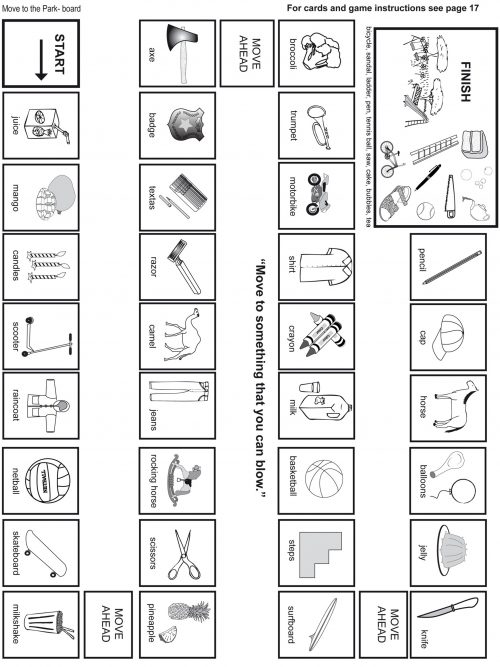
Level 2
Identifying objects according to their function/use Level 2 ““What do you use … for?” “What do you use to ...?” “What do you do with a ...?” “Find something that you can…” Scanning for an object defined by its function Level 2 “Find something that you can dig with.” “Show me something that I can use to ...” “Point to the ones that I can drink.” “Touch the ones that you can drive.” This program provides opportunities to teach more verbs and help children understand that objects have functions - Playing the games provided in this program will increase your child’s command of verbs (action words) and help to expand his/her vocabulary and sentences. Working through the provided activities will help your child understand the link between objects and functions and will ensure that he/she remains engaged in the presented tasks. Research indicates that vocabulary size is a major contributor to language development. It is important for children to make a meaningful connection between an object and an action and thus expand their vocabulary. Verbs lay the foundation for the meaning of early sentences. Providing additional connections such as understanding functions, helps a child learn and find words in a more timely manner. Example of a game: This This game does not require a die. The movement cards describe an action. These cards are cut up and placed face down in a pile next to the board. Each player takes turns to pick up a card from the pile, saying the words ... “Move to something that you can ...” The player moves his/her counter to the first square on the track which matches the action card selected. Cards are placed in the discard pile after each turn. When all the cards have been discarded, the stack should be turned over and the players continue drawing cards from the pile, creating a sentence and moving to a matching object until one player reaches the finish. -
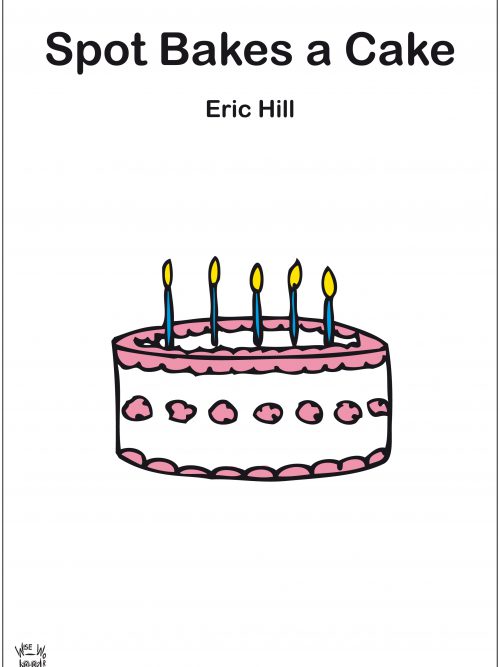 USING BOOKS TO ENHANCE A CHILD'S UNDERSTANDING AND INCREASE HIS/HER EXPRESSIVE LANGUAGE You can use a book to expand a child's • Vocabulary (calendar, trolley, bowl, apron, shopping, mixing, drawing) • Understanding of concepts (messy, sticky, many, hot, delicious) • Ability to understand questions Wise Words Scripts - offer clinicians, teachers and parents readily available questions designed specifically for each book. A script provides a variety of questions at each level of understanding for each page of the book. A teacher or clinician working with a group of children can tailor questions to each child's language ability. This script and other available scripts have been based on Marion Blank's Model of Classroom Language. Marion Blank recognised the importance of keeping questions and statements within a child’s level of understanding. The more concrete the statement or question, the easier it will be for the child to understand. As questions become more abstract, they become harder for children to answer. The Blank Model is divided into 4 levels of questioning, moving from the concrete (easiest) at Level 1 to the abstract (most difficult) at Level 4.
USING BOOKS TO ENHANCE A CHILD'S UNDERSTANDING AND INCREASE HIS/HER EXPRESSIVE LANGUAGE You can use a book to expand a child's • Vocabulary (calendar, trolley, bowl, apron, shopping, mixing, drawing) • Understanding of concepts (messy, sticky, many, hot, delicious) • Ability to understand questions Wise Words Scripts - offer clinicians, teachers and parents readily available questions designed specifically for each book. A script provides a variety of questions at each level of understanding for each page of the book. A teacher or clinician working with a group of children can tailor questions to each child's language ability. This script and other available scripts have been based on Marion Blank's Model of Classroom Language. Marion Blank recognised the importance of keeping questions and statements within a child’s level of understanding. The more concrete the statement or question, the easier it will be for the child to understand. As questions become more abstract, they become harder for children to answer. The Blank Model is divided into 4 levels of questioning, moving from the concrete (easiest) at Level 1 to the abstract (most difficult) at Level 4. -
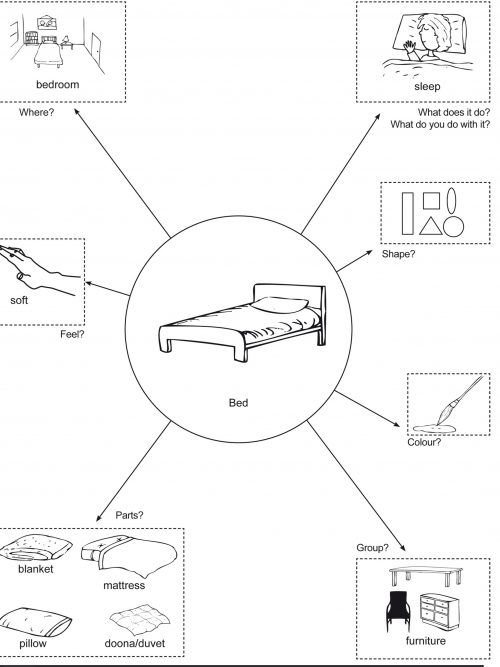
Level 3
Defining Words Level 3 “What is a ...?” “Tell me what a ... is.” “Tell me what ... are.” Mind Maps will help your child to- Talk about and describe an object
- Give 'news'
- Expand his/her vocabulary
- Find the right word
- Increase his/her descriptive language
- Answer questions
- Ask questions
- Where do you find it?
- What does it do? What can you do with it?
- What shape is it?
- What colour is it?
- What group (semantic class) does it belong in?
- What noise does it make?
- What parts does it have? (Labeling the parts of objects greatly increases a child's vocabulary. For example - fleece, hooves of a sheep)
- How does it feel (when touched)?
- When your child becomes competent with the object specific prompts you should introduce the generic mind map which is provided at the end of the program.
-
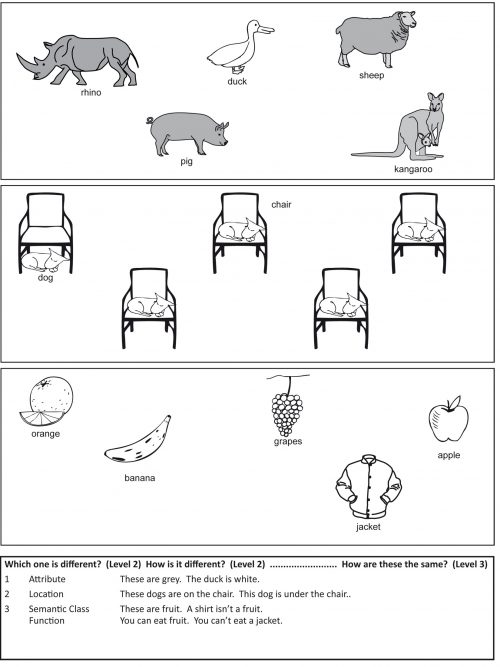
Level 2 and Level 3
Identifying Differences Level 2 “Which one is different?" "Which one is not the same?" "Which one doesn’t match?" "How are these different?" Identifying Similarities Level 3 “How are these the same?" The first activity (Level 2) will help your child to identify differences and be able to explain how something is different. This is an important skill as it directs the child’s attention to further aspects or properties of an item. This Level 2 question is simpler than the more complex question “How are these the same?” The second activity (Level 3) will help your child to identify similarities within a group of objects. This is an important skill for children to acquire as they are often able to recognise differences between objects and yet they cannot always explain how objects can share similarities. This Level 3 question is more complex because now your child has to perceive similarities between objects which may, or may not, be obvious or immediately perceived . Example of a Level 2 Activity Ask your child to point to and name the objects: “Dog, duck, pig, sheep, horse” Now ask: “Which one is different?” - "Duck" If your child points to the correct item but does not verbalise, she should be encouraged to name the item. - “duck.” Point to the duck and ask: “How is it different?” - “The duck is white. The other animals are grey.” Point to the duck and ask: “How is it different?” - “The duck is white. The other animals are grey.” Example of a Level 3 Activity Ask your child to point to and name the objects: "Needle, knife, scissors, apron, saw" Now cover the apron with card and whilst pointing to the remaining objects ask: "How are these the same?" - “These are sharp. An apron isn't sharp.” -
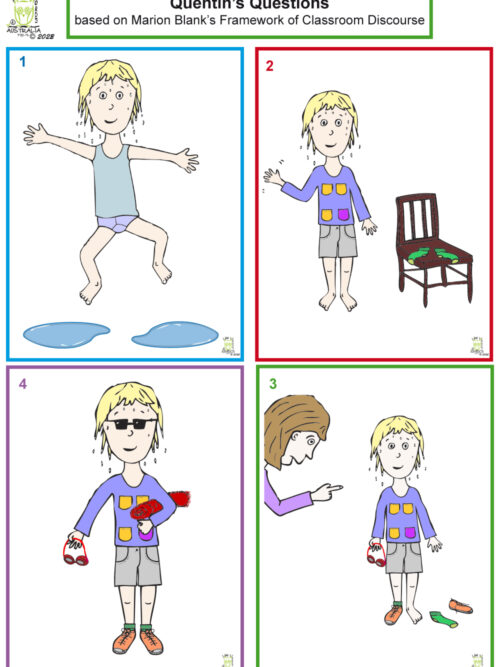 This product includes four picture cards depicting a young boy. Each illustration has accompanying questions at Levels 1, 2, 3 and 4 and are based on Marion Blank’s Model of Classroom Language. (Blank, Rose & Berlin 1978). The cards will provide teachers and clinicians with a useful tool where questions and statements can be quickly tailored to the needs of every child despite differing ages or abilities.
This product includes four picture cards depicting a young boy. Each illustration has accompanying questions at Levels 1, 2, 3 and 4 and are based on Marion Blank’s Model of Classroom Language. (Blank, Rose & Berlin 1978). The cards will provide teachers and clinicians with a useful tool where questions and statements can be quickly tailored to the needs of every child despite differing ages or abilities. -
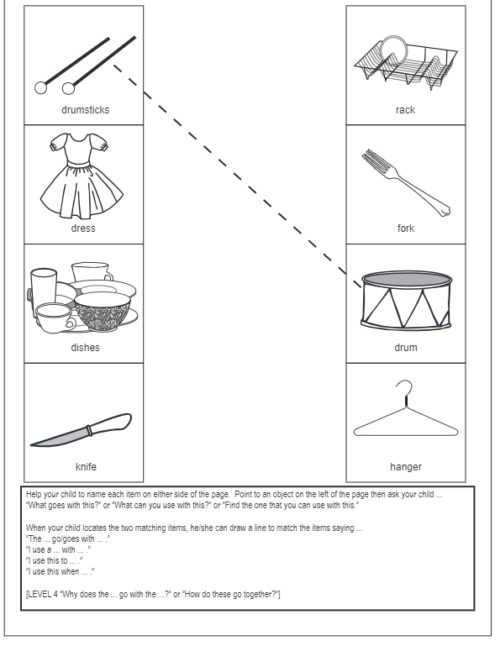
Level 3 (& Level 4)
Identifying Objects Used With Each Other Level 3 “Find the one to use with this.” “What can you use this with?” “What goes with this?” “Which objects are used together?” “Find the one that can be used with ... .” Justifying a Prediction Level 4 “Why would you use a ... to ... ?” “Why does a ... go with ... ?” “How does a ... go with ... ?” “Why should we use a ... to ... ?” Why doesn’t a ... go with ... ? This task requires a child to identify objects which can be used together. The task can be extended to Level 4 where the child is required to explain why objects are used together and why certain objects are not used together. -
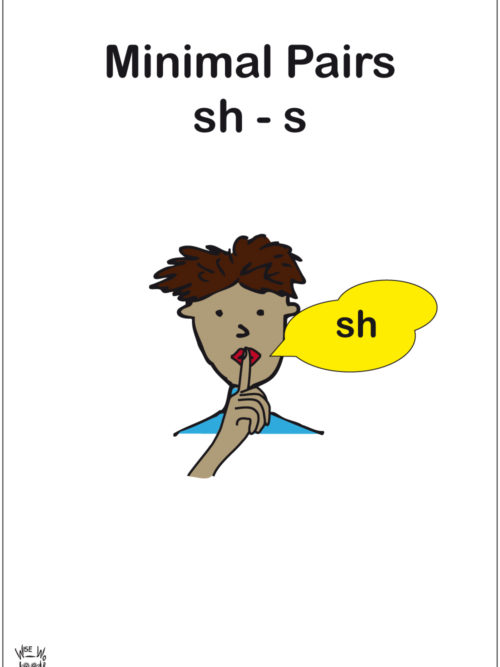 All Wise Words Programs are sent as a download unless otherwise specified. To ship a USB, please add either Australian (A$20) or International (A$55) shipping to shopping cart. Using Contrastive Pairs Although many children may progress quickly through a regular articulation program, some respond better using a phonological approach. This program uses the contrastive phonological approach of Minimal Pairs. The use of Minimal Pairs is supported by evidence-based practice and has been shown to be an effective and efficient treatment for contrasting vowels or consonants. Once the ‘sh’ sound has been established in single, meaningful words, this program can be used. Working through this program will help your child hear and use the sound correctly to affect a change in meaning. Although your child is generally able to identify your ‘sh’ vs ‘s’ productions, he may use the error sound ‘s’ for any ‘sh’ words. e.g. He may say … ‘Sue’ when he means to say ‘shoe’ ‘wassing’ when he means to say ‘washing’ ‘fiss’ when he means to say ‘fish’ As he says the words, he may not recognise that he is using an incorrect sound. These sound errors can affect his intelligibility and will change the meaning in his connected speech.
All Wise Words Programs are sent as a download unless otherwise specified. To ship a USB, please add either Australian (A$20) or International (A$55) shipping to shopping cart. Using Contrastive Pairs Although many children may progress quickly through a regular articulation program, some respond better using a phonological approach. This program uses the contrastive phonological approach of Minimal Pairs. The use of Minimal Pairs is supported by evidence-based practice and has been shown to be an effective and efficient treatment for contrasting vowels or consonants. Once the ‘sh’ sound has been established in single, meaningful words, this program can be used. Working through this program will help your child hear and use the sound correctly to affect a change in meaning. Although your child is generally able to identify your ‘sh’ vs ‘s’ productions, he may use the error sound ‘s’ for any ‘sh’ words. e.g. He may say … ‘Sue’ when he means to say ‘shoe’ ‘wassing’ when he means to say ‘washing’ ‘fiss’ when he means to say ‘fish’ As he says the words, he may not recognise that he is using an incorrect sound. These sound errors can affect his intelligibility and will change the meaning in his connected speech. -
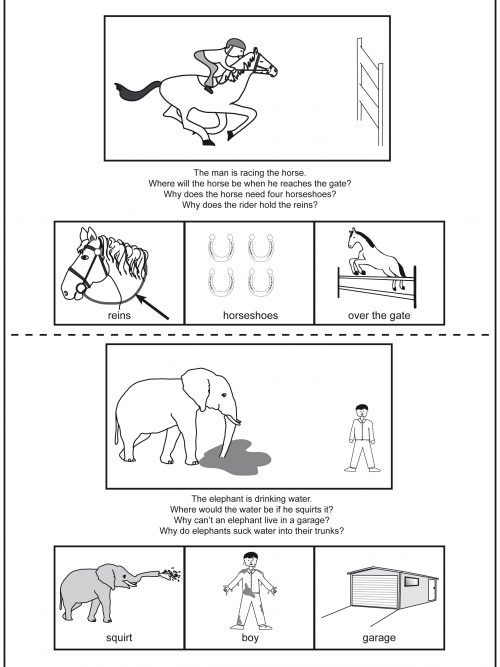
Level 4
Predicting changes in position “What will you see if ...?” “Where will the ... be if ...?” Explaining the means to a goal “Why did the ...?” “Why should he ...?” Explaining obstacles to an action “Why can’t the helicopter ...?” “Why won’t the ...?” This program can be used with both readers and non-readers alike. If a child can read, it is suggested that the ‘without words’ version is used to avoid reliance on the written prompt. Parents or carers have access to the written label in order to guide their child with each task. It is important for the parent, teacher or clinician to lead the child towards the salient features of the presented information. Point to a picture, parts of a picture or break down the statements into simple content in order to give the child an opportunity to understand. If your child appears to be struggling with the questions, it is essential to talk more but at a simple level of understanding so that the child reaches the appropriate response by himself. Rephrasing the information will ensure that he is able to draw on past experiences or make inferences. This should help him to understand the question and then offer a solution. -
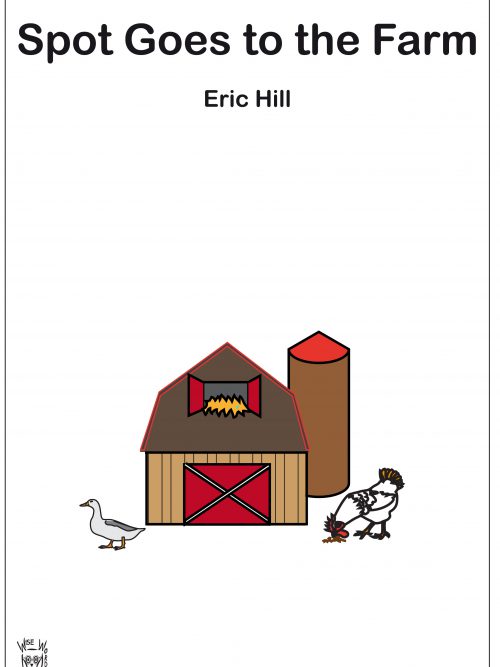 USING BOOKS TO ENHANCE A CHILD'S UNDERSTANDING AND INCREASE HIS/HER EXPRESSIVE LANGUAGE You can use a book to expand a child's • vocabulary (tractor, driving, wheels, stable, bucket, straw, sheep, pegs) • understanding of concepts (e.g. wet, dry, soft, behind, in) • ability to understand questions Wise Words Scripts - offer clinicians, teachers and parents readily available questions designed specifically for each book. A script provides a variety of questions at each level of understanding for each page of the book. A teacher or clinician working with a group of children can tailor questions to each child's language ability. This script and other available scripts have been based on Marion Blank's Model of Classroom Language. Marion Blank recognised the importance of keeping questions and statements within a child’s level of understanding. The more concrete the statement or question, the easier it will be for the child to understand. As questions become more abstract, they become harder for children to answer. The Blank Model is divided into 4 levels of questioning, moving from the concrete (easiest) at Level 1 to the abstract (most difficult) at Level 4.
USING BOOKS TO ENHANCE A CHILD'S UNDERSTANDING AND INCREASE HIS/HER EXPRESSIVE LANGUAGE You can use a book to expand a child's • vocabulary (tractor, driving, wheels, stable, bucket, straw, sheep, pegs) • understanding of concepts (e.g. wet, dry, soft, behind, in) • ability to understand questions Wise Words Scripts - offer clinicians, teachers and parents readily available questions designed specifically for each book. A script provides a variety of questions at each level of understanding for each page of the book. A teacher or clinician working with a group of children can tailor questions to each child's language ability. This script and other available scripts have been based on Marion Blank's Model of Classroom Language. Marion Blank recognised the importance of keeping questions and statements within a child’s level of understanding. The more concrete the statement or question, the easier it will be for the child to understand. As questions become more abstract, they become harder for children to answer. The Blank Model is divided into 4 levels of questioning, moving from the concrete (easiest) at Level 1 to the abstract (most difficult) at Level 4. -
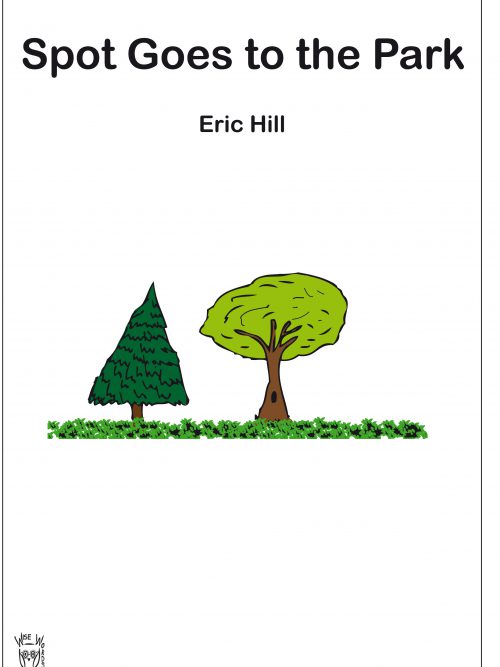 USING BOOKS TO ENHANCE A CHILD'S UNDERSTANDING AND INCREASE HIS/HER EXPRESSIVE LANGUAGE You can use a book to expand a child's • vocabulary (park, cards, wagging, looking, gate, scaring, newspaper) • understanding of concepts (e.g. accident, high, over, grateful, frightened) • ability to understand questions Wise Words Scripts - offer clinicians, teachers and parents readily available questions designed specifically for each book. A script provides a variety of questions at each level of understanding for each page of the book. A teacher or clinician working with a group of children can tailor questions to each child's language ability. This script and other available scripts have been based on Marion Blank's Model of Classroom Language. Marion Blank recognised the importance of keeping questions and statements within a child’s level of understanding. The more concrete the statement or question, the easier it will be for the child to understand. As questions become more abstract, they become harder for children to answer. The Blank Model is divided into 4 levels of questioning, moving from the concrete (easiest) at Level 1 to the abstract (most difficult) at Level 4.
USING BOOKS TO ENHANCE A CHILD'S UNDERSTANDING AND INCREASE HIS/HER EXPRESSIVE LANGUAGE You can use a book to expand a child's • vocabulary (park, cards, wagging, looking, gate, scaring, newspaper) • understanding of concepts (e.g. accident, high, over, grateful, frightened) • ability to understand questions Wise Words Scripts - offer clinicians, teachers and parents readily available questions designed specifically for each book. A script provides a variety of questions at each level of understanding for each page of the book. A teacher or clinician working with a group of children can tailor questions to each child's language ability. This script and other available scripts have been based on Marion Blank's Model of Classroom Language. Marion Blank recognised the importance of keeping questions and statements within a child’s level of understanding. The more concrete the statement or question, the easier it will be for the child to understand. As questions become more abstract, they become harder for children to answer. The Blank Model is divided into 4 levels of questioning, moving from the concrete (easiest) at Level 1 to the abstract (most difficult) at Level 4. -
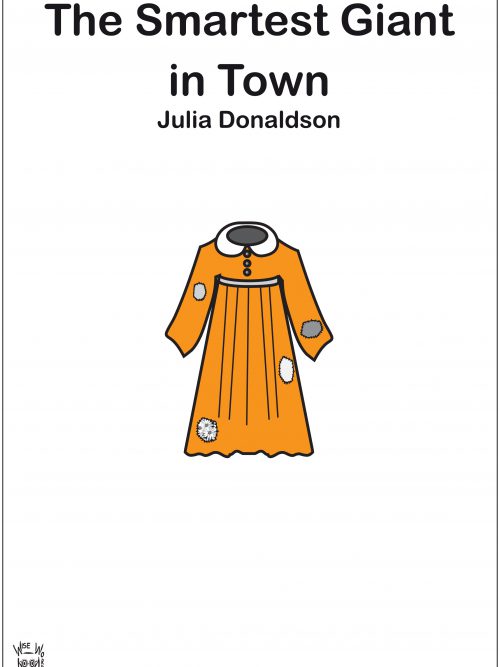 USING BOOKS TO ENHANCE A CHILD'S UNDERSTANDING AND INCREASE HIS/HER EXPRESSIVE LANGUAGE You can use a book to expand your child's • Vocabulary (magnificent, sail, squelchy, sniffing) • Understanding of concepts (cold, round, white, cosy, kind) • Ability to understand questions Wise Words Scripts - offer clinicians, teachers and parents readily available questions designed specifically for each book. A script provides a variety of questions at each level of understanding for each page of the book. A teacher or clinician working with a group of children can tailor questions to each child's language ability. This script and other available scripts have been based on Marion Blank's Model of Classroom Language. Marion Blank recognised the importance of keeping questions and statements within a child’s level of understanding. The more concrete the statement or question, the easier it will be for the child to understand. As questions become more abstract, they become harder for children to answer. The Blank Model is divided into 4 levels of questioning, moving from the concrete (easiest) at Level 1 to the abstract (most difficult) at Level 4.
USING BOOKS TO ENHANCE A CHILD'S UNDERSTANDING AND INCREASE HIS/HER EXPRESSIVE LANGUAGE You can use a book to expand your child's • Vocabulary (magnificent, sail, squelchy, sniffing) • Understanding of concepts (cold, round, white, cosy, kind) • Ability to understand questions Wise Words Scripts - offer clinicians, teachers and parents readily available questions designed specifically for each book. A script provides a variety of questions at each level of understanding for each page of the book. A teacher or clinician working with a group of children can tailor questions to each child's language ability. This script and other available scripts have been based on Marion Blank's Model of Classroom Language. Marion Blank recognised the importance of keeping questions and statements within a child’s level of understanding. The more concrete the statement or question, the easier it will be for the child to understand. As questions become more abstract, they become harder for children to answer. The Blank Model is divided into 4 levels of questioning, moving from the concrete (easiest) at Level 1 to the abstract (most difficult) at Level 4. -
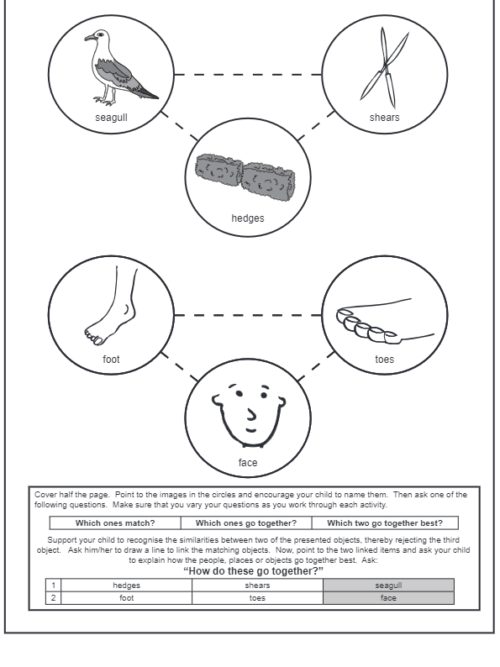
Level 3
Explaining Similarities Find the ones that go together best. Find the ones that match. How are these the same? How do these go together? Although a child may be able to recognise differences between objects, often he is not able to explain how similarities can be shared. At Level 3, the child is required to perceive relationships between items which may, or may not, be immediately obvious. He may need to draw on past experiences or knowledge rather than rely on the ‘here and now’ features or the more obvious characteristics. A set of pictures may have more than one similarity. For example: a foot, a face and toes are similar as they are all parts of the body (same semantic class). The child then needs to recognise that a closer relationship exists - that the toes are part of a foot. -
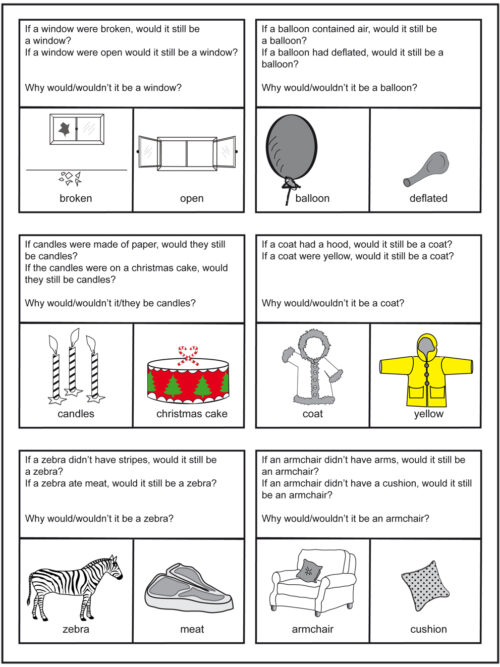
Level 4
Justifying a Decision Based on Characteristics
This program is underpinned by Marion Blank’s Model of Classroom Language. The activities presented in this program involve more complex verbal ideas and are based on Blank’s model. For your child to be able to succeed with these tasks, he will need to extend beyond what can be immediately seen or perceived. He will need to reason and make decisions based on the attributes of objects, considering possibilities which may not be immediately obvious, reflecting on previous experiences and information. He will be required to use this information to reason and respond.
-
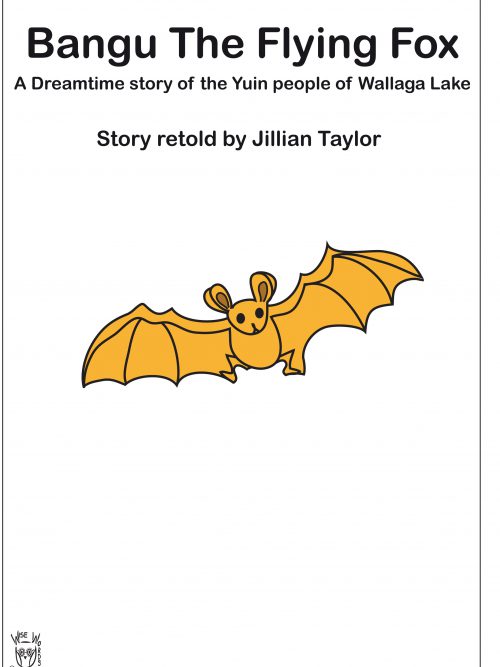 Wise Words indigenous materials have been devised to support parents, teachers and clinicians who may find it challenging to teach indigenous content because of concerns that they may not have the knowledge or understanding to ensure that the books, their stories and the complexity of the information is presented in a respectful and appropriate manner. With thanks to Tara Lewis who kindly edited these resources. Tara Lewis is a Speech Pathologist and member of Speech Pathology Australia's Aboriginal and Torres Strait Islander Advisory Committee. Tara is an Iman woman from the Taroom country of Western Queensland. The Australian Curriculum has established Aboriginal and Torres Strait Islander histories and cultures as a priority. This will ensure that Aboriginal and Torres Strait Islander students are able to see themselves, their identities and their cultures reflected in the curriculum of each of the learning areas. Exposure to these and other indigenous books can build awareness of and respect for Aboriginal and Torres Strait Islander histories and cultures amongst all Australian children. USING BOOKS TO ENHANCE A CHILD'S UNDERSTANDING AND INCREASE HIS/HER EXPRESSIVE LANGUAGE You can use a book to expand a child's • Vocabulary (world, fighting, winning, pretending, crept) • Understanding of concepts (e.g. new, many, frightened, around, lonely) • Ability to understand questions Bangu The Flying Fox details a traditional Dreaming story from the Yuin people of Wallaga Lake. Bangu explores the importance of belonging and identification. Wise Words Scripts - offer clinicians, teachers and parents readily available questions designed specifically for each book. A script provides a variety of questions at each level of understanding for each page of the book. A teacher or clinician working with a group of children can tailor questions to each child's language ability. This script and other available scripts have been based on Marion Blank's Model of Classroom Language.
Wise Words indigenous materials have been devised to support parents, teachers and clinicians who may find it challenging to teach indigenous content because of concerns that they may not have the knowledge or understanding to ensure that the books, their stories and the complexity of the information is presented in a respectful and appropriate manner. With thanks to Tara Lewis who kindly edited these resources. Tara Lewis is a Speech Pathologist and member of Speech Pathology Australia's Aboriginal and Torres Strait Islander Advisory Committee. Tara is an Iman woman from the Taroom country of Western Queensland. The Australian Curriculum has established Aboriginal and Torres Strait Islander histories and cultures as a priority. This will ensure that Aboriginal and Torres Strait Islander students are able to see themselves, their identities and their cultures reflected in the curriculum of each of the learning areas. Exposure to these and other indigenous books can build awareness of and respect for Aboriginal and Torres Strait Islander histories and cultures amongst all Australian children. USING BOOKS TO ENHANCE A CHILD'S UNDERSTANDING AND INCREASE HIS/HER EXPRESSIVE LANGUAGE You can use a book to expand a child's • Vocabulary (world, fighting, winning, pretending, crept) • Understanding of concepts (e.g. new, many, frightened, around, lonely) • Ability to understand questions Bangu The Flying Fox details a traditional Dreaming story from the Yuin people of Wallaga Lake. Bangu explores the importance of belonging and identification. Wise Words Scripts - offer clinicians, teachers and parents readily available questions designed specifically for each book. A script provides a variety of questions at each level of understanding for each page of the book. A teacher or clinician working with a group of children can tailor questions to each child's language ability. This script and other available scripts have been based on Marion Blank's Model of Classroom Language. -
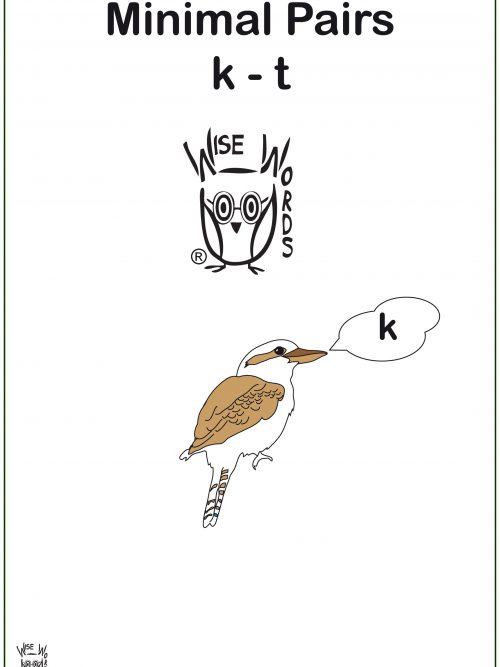 Using Contrastive Pairs Although many children may progress quickly through a regular articulation program, some respond better using a phonological approach. This program uses the contrastive phonological approach of Minimal Pairs. The use of Minimal Pairs is supported by evidence-based practice and has been shown to be an effective and efficient treatment for contrasting vowels or consonants. Once the ‘k’ sound has been established in single, meaningful words, this program can be used. It will help your child hear and use the sound correctly to affect a change in meaning. Although your child is generally able to identify your ‘k’ productions, he may use the error sound ‘t’ for any ‘k’ words. e.g. He may say ... ‘tea’ when he means to say ‘key’ ‘luttee’ when he means to say ‘lucky’ ‘beat’ when he means to say ‘beak’ As he says the words, he may not recognise that he is using an incorrect sound. These sound errors can affect his intelligibility and will change the meaning in his connected speech.
Using Contrastive Pairs Although many children may progress quickly through a regular articulation program, some respond better using a phonological approach. This program uses the contrastive phonological approach of Minimal Pairs. The use of Minimal Pairs is supported by evidence-based practice and has been shown to be an effective and efficient treatment for contrasting vowels or consonants. Once the ‘k’ sound has been established in single, meaningful words, this program can be used. It will help your child hear and use the sound correctly to affect a change in meaning. Although your child is generally able to identify your ‘k’ productions, he may use the error sound ‘t’ for any ‘k’ words. e.g. He may say ... ‘tea’ when he means to say ‘key’ ‘luttee’ when he means to say ‘lucky’ ‘beat’ when he means to say ‘beak’ As he says the words, he may not recognise that he is using an incorrect sound. These sound errors can affect his intelligibility and will change the meaning in his connected speech. -
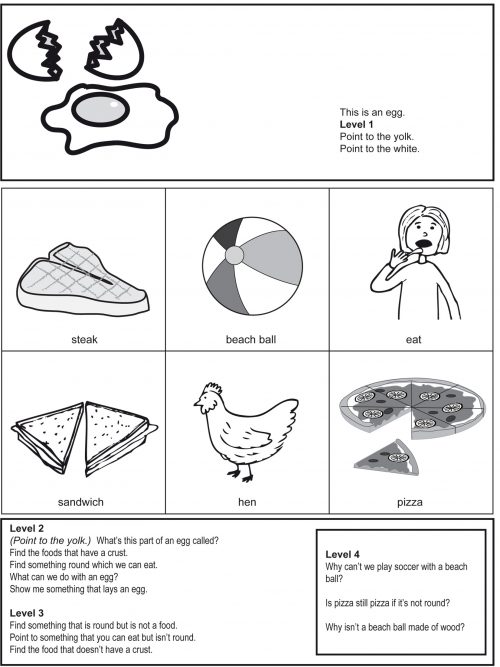
Levels 2 - 4
Attending to Two Characteristics Naming the Parts of Objects Identifying an Object by its Function Level 2 “Find something that is round and we can eat.” “What is this part of a ... called?” “What do we use this for?” Selecting an Object by Exclusion Selecting a Set of Objects by Exclusion Level 3 “Find all the ones that are not animals." "Tell me something that is not big." “Show me something that can jump but is not a horse." Reasoning and Problem Solving Level 4 “If a bicycle wheel were square would it still be a wheel?” “Why are gumboots made of rubber?” “What will happen if ...?” "Why is a raincoat called a raincoat?" The first part of this program has been designed to help your child recognise and name parts of objects and respond to questions which focus on the object's properties and functions. (eg Selecting an object according to two characteristics – “Find the one that has an engine and wings.”) The second part of this program targets exclusion. This requires your child to overcome the urge to respond to a key word or salient perceptual material. (eg “Point to something that you can eat but isn’t round. Find something that flies in the sky but doesn't have wings.”) The final part of this program represents complex verbal problems that require a child to reason about what may, might, could or would happen to material/objects under specific circumstances. Your child will need to problem solve and formulate solutions using logic and past knowledge. Although the question may relate to an object pictured on the page, the solution to the question is not present. Example of tasks/activities Level 2 Find something round which we can eat. What's this part of a helicopter called? Level 3 Point to something that you can eat but isn't round. Point to something that is a boat but doesn't have sails. Level 4 Why isn't a beach ball made of wood? Would a soccer ball still be a soccer ball if it were an oval shape?
